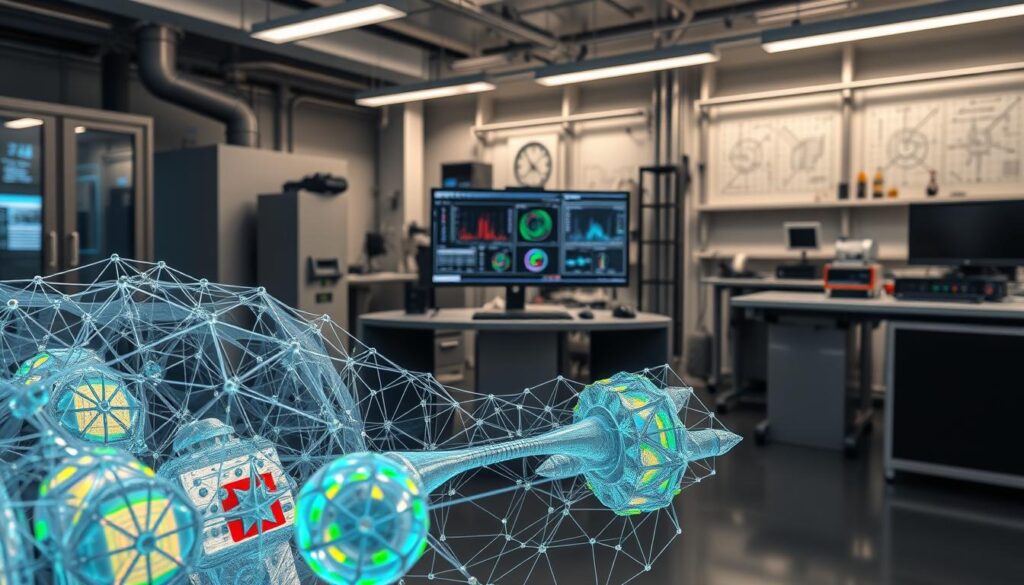At the intersection of scientific inquiry and technological innovation lies the field of Engineering Physics. This discipline combines the principles of physics with the practical needs of engineering to drive advancements in various fields.
Engineering Physics serves as a bridge between the theoretical foundations of physics and the practical applications of engineering. By understanding and applying physics concepts, engineers can develop innovative solutions to real-world problems.
Key Takeaways
- Understanding the role of Engineering Physics in technological advancements.
- The application of physics concepts in engineering.
- The importance of applied physics in driving innovation.
- Bridging the gap between scientific principles and engineering practices.
- The significance of engineering principles in real-world applications.
The Interdisciplinary Nature of Engineering Physics
The field of Engineering Physics is inherently interdisciplinary, combining the rigor of physics with the creativity of engineering. This unique blend enables engineers to tackle complex problems that require both a deep understanding of physical principles and the ability to apply them in innovative ways.
Defining the Field at the Intersection of Science and Application
Engineering Physics is defined by its position at the intersection of scientific inquiry and practical application. It involves the use of physics principles to develop new technologies and solve engineering challenges. As noted by a leading physicist,
“The application of physics to engineering problems is what drives innovation and progress in our field.”
Historical Development of Engineering Physics
The historical development of Engineering Physics is rooted in the early 20th century when scientists began applying quantum mechanics and relativity to technological problems. Over time, this field has evolved to incorporate a wide range of engineering concepts and physics applications in engineering, making it a cornerstone of modern technological advancements.
The interdisciplinary nature of Engineering Physics has led to significant breakthroughs in various fields, from materials science to telecommunications. By combining scientific engineering principles with practical problem-solving skills, engineers in this field are equipped to address the complex challenges of the modern world.
Fundamental Physics Concepts in Engineering
Fundamental physics concepts form the backbone of various engineering disciplines. These principles are crucial for understanding and applying scientific knowledge to real-world problems.
Classical Mechanics and Its Engineering Applications
Classical mechanics, a foundational aspect of physics, deals with the motion of macroscopic objects under the influence of forces. Its applications in engineering are vast, ranging from the design of mechanical systems to the analysis of structural integrity in buildings. Newton’s laws of motion are pivotal in understanding how forces affect the motion of objects.

Conservation Laws and Their Practical Implications
Conservation laws, including the conservation of energy, momentum, and mass, have significant implications in engineering. For instance, the conservation of energy is fundamental in designing efficient systems, such as renewable energy technologies. As noted by a renowned physicist, “Energy cannot be created or destroyed, only transformed.” This principle guides engineers in optimizing energy use.
“The law of conservation of energy states that the total energy of an isolated system remains constant.”
Mathematical Modeling of Physical Systems
Mathematical modeling is a critical tool in engineering physics, allowing for the simulation and analysis of complex physical systems. By applying mathematical techniques to physical problems, engineers can predict system behavior under various conditions. This is particularly important in fields like aerospace engineering, where computational fluid dynamics is used to model airflow around aircraft.
| Physics Concept | Engineering Application |
|---|---|
| Classical Mechanics | Design of Mechanical Systems |
| Conservation Laws | Efficient Energy Systems |
| Mathematical Modeling | Simulation of Complex Systems |
Engineering Physics or Engineering Science: Understanding the Terminology
The terms “Engineering Physics” and “Engineering Science” are often used interchangeably, but they have distinct meanings depending on the context. Understanding these differences is essential for students and professionals in these fields.
Comparing Definitions and Approaches
Engineering Physics typically focuses on the application of fundamental physical principles to develop innovative solutions. It often involves a strong emphasis on experimental techniques and theoretical understanding. On the other hand, Engineering Science tends to encompass a broader range of engineering disciplines, integrating principles from physics, mathematics, and other sciences to address complex engineering challenges.
Key differences in their approaches include:
- The scope of the curriculum, with Engineering Physics often delving deeper into the physics underlying engineering systems.
- The focus on experimental and theoretical work, with Engineering Physics typically requiring a strong foundation in both.
As noted by experts, “The distinction between Engineering Physics and Engineering Science can significantly impact the structure and content of educational programs.” This, in turn, affects the skill set and knowledge base of graduates entering the workforce.
Regional and Institutional Differences in Nomenclature
Regional and institutional differences play a significant role in the nomenclature used for these programs. For instance, some universities may offer “Engineering Science” programs that are virtually identical to “Engineering Physics” programs at other institutions.
| Institution Type | Common Terminology | Curriculum Focus |
|---|---|---|
| Technical Universities | Engineering Physics | Theoretical and Experimental Physics |
| Comprehensive Universities | Engineering Science | Broad Engineering Disciplines |
In conclusion, while both terms refer to interdisciplinary fields that combine principles from physics and engineering, the specific focus and curriculum can vary significantly between institutions and regions.
Thermodynamics and Heat Transfer in Engineering
Understanding thermodynamics and heat transfer is vital for engineers, as these concepts are pivotal in the creation of efficient and sustainable systems. Thermodynamics, the study of the relationship between heat and other forms of energy, is fundamental to the design and operation of various engineering systems.
Principles of Thermal Energy and Efficiency
The principles of thermal energy and efficiency are crucial in engineering. The efficiency of a system is often determined by its ability to convert input energy into useful work. The laws of thermodynamics, particularly the second law, provide a framework for understanding and optimizing this efficiency. Efficient thermal energy conversion is key to reducing energy losses and improving overall system performance.

Applications in Power Generation Systems
In power generation systems, thermodynamics plays a critical role. Thermal power plants, for example, rely on the principles of thermodynamics to convert heat energy into electrical energy. The efficiency of these plants is a major concern, with ongoing research aimed at improving heat transfer and reducing energy losses. Advances in materials and technologies have led to more efficient power generation systems.
| Application | Description | Efficiency Improvement |
|---|---|---|
| Thermal Power Plants | Conversion of heat to electrical energy | Advanced materials and cooling systems |
| Heat Exchangers | Transfer of heat between fluids | Optimized design for minimal energy loss |
Thermal Management in Electronic Devices
Thermal management is also crucial in electronic devices, where excessive heat can lead to reduced performance and lifespan. Techniques such as heat sinks, thermal interfaces, and advanced cooling systems are used to manage heat transfer and maintain optimal operating temperatures. Effective thermal management enables the development of more powerful and compact electronic devices.
“The ability to manage heat transfer is a critical aspect of modern engineering, influencing everything from the efficiency of power generation to the reliability of electronic devices.”
By understanding and applying the principles of thermodynamics and heat transfer, engineers can develop innovative solutions that enhance the efficiency, sustainability, and performance of various systems and technologies.
Electromagnetism: Powering Modern Technology
At the heart of modern technology lies the powerful force of electromagnetism. This fundamental physical phenomenon has enabled numerous breakthroughs in various fields, including electrical engineering, electronics, and communication systems.
Electromagnetic Theory in Electrical Engineering
Electromagnetic theory forms the backbone of electrical engineering, providing the principles necessary for designing and developing electrical systems. It encompasses the study of electric and magnetic fields and their interactions, which is crucial for understanding how electrical devices operate.
Applications in Electronics and Communication Systems
The applications of electromagnetism are vast, ranging from simple electronic devices to complex communication systems. For instance, electromagnetic waves are used in wireless communication, enabling mobile phones and satellite communications to function. Some key applications include:
- Wireless communication systems
- Radio frequency identification (RFID)
- Microwave ovens and medical equipment
- Optical fiber communications
Electromagnetic Compatibility in Design
As electronic devices become increasingly sophisticated and ubiquitous, ensuring electromagnetic compatibility (EMC) is critical. EMC design principles help prevent electromagnetic interference (EMI) between devices, ensuring they operate as intended in their electromagnetic environment.
By understanding and applying the principles of electromagnetism, engineers can develop innovative solutions that transform our daily lives. From powering homes and industries to enabling global communication networks, electromagnetism continues to be a driving force behind modern technological advancements.
Quantum Mechanics and Its Engineering Applications
Advances in quantum mechanics are paving the way for groundbreaking engineering applications. The integration of quantum principles into engineering is transforming various fields, from electronics to computing.
Quantum Principles in Semiconductor Technology
Quantum mechanics plays a crucial role in the development of semiconductor technology. Semiconductor devices, such as transistors, rely on quantum principles to control the flow of electrical current. The understanding of quantum tunneling and other phenomena has enabled the creation of smaller, faster, and more efficient devices.
![]()
Quantum Computing: Principles and Potential
Quantum computing represents a significant leap forward in computational power, leveraging quantum bits or qubits to perform calculations at unprecedented speeds. Quantum computing has the potential to solve complex problems that are currently unsolvable with traditional computers, opening new avenues in fields like cryptography and complex system simulation.
Quantum Sensors and Measurement Techniques
Quantum sensors utilize the principles of quantum mechanics to achieve highly precise measurements. These sensors are being applied in various engineering fields, including navigation and geophysical exploration. Quantum measurement techniques are also enhancing the accuracy of scientific instruments, contributing to advancements in research and development.
The applications of quantum mechanics in engineering are vast and varied, promising to revolutionize multiple industries. Some key areas include:
- Enhanced computing capabilities through quantum computing
- Improved semiconductor devices for electronics
- High-precision measurement and sensing technologies
As research continues to advance, the integration of quantum mechanics into engineering will likely lead to further innovations, driving technological progress and economic growth.
Materials Science: The Foundation of Engineering Innovation
The foundation of engineering innovation lies in materials science, which applies physical principles to understand material properties. This field is crucial for developing new materials and technologies that drive advancements in various engineering disciplines.
Understanding Material Properties Through Physics
Physics plays a vital role in understanding the properties of materials. By applying principles from mechanics, thermodynamics, and electromagnetism, researchers can analyze and predict how materials behave under different conditions. This understanding is essential for selecting and designing materials for specific engineering applications.
Advanced Materials Development and Applications
The development of advanced materials, such as composites and smart materials, has revolutionized various engineering fields. These materials offer enhanced properties, such as strength, conductivity, and responsiveness to environmental stimuli, enabling innovative solutions in aerospace, biomedical, and energy applications.
Nanomaterials and Their Unique Properties
Nanomaterials, with their dimensions on the nanoscale, exhibit unique properties that differ significantly from their bulk counterparts. These properties make nanomaterials ideal for applications in electronics, medicine, and energy storage, among others. Research in nanomaterials continues to uncover new possibilities for engineering innovation.
In conclusion, materials science is a driving force behind engineering innovation, leveraging physics to understand and develop materials with tailored properties. The ongoing research and development in this field promise to deliver new materials and technologies that will shape the future of engineering.
Waves, Optics, and Acoustics in Engineering Design
The integration of wave phenomena, optical engineering, and acoustic principles is revolutionizing the field of engineering design. Understanding these fundamental concepts is crucial for developing innovative solutions across various engineering disciplines.
Wave Phenomena and Their Engineering Relevance
Wave phenomena, including reflection, refraction, and diffraction, play a significant role in various engineering applications. For instance, understanding wave behavior is essential in designing optical communication systems and seismic exploration techniques. Wave analysis helps engineers predict and mitigate potential issues in complex systems.

Optical Engineering and Photonics
Optical engineering and photonics have transformed numerous industries by enabling the development of high-speed data transmission, precise measurement tools, and advanced sensing technologies. Photonics, in particular, has led to breakthroughs in telecommunications and medical imaging. As stated by a leading researcher, “Photonics is at the heart of many modern technologies, from internet connectivity to medical diagnostics.”
“The future of optical engineering lies in the integration of photonics with other disciplines, such as nanotechnology and artificial intelligence.”
Acoustic Engineering and Noise Control
Acoustic engineering focuses on the manipulation of sound waves to improve product design, reduce noise pollution, and enhance audio technologies. Effective noise control measures are critical in various settings, including industrial environments, transportation systems, and residential areas. Techniques such as soundproofing and active noise cancellation are employed to achieve these goals.
| Application | Description | Benefits |
|---|---|---|
| Soundproofing | Using materials to absorb or block sound | Reduced noise pollution, improved privacy |
| Active Noise Cancellation | Generating a noise-cancelling signal | Enhanced audio quality, reduced ambient noise |
In conclusion, the study of waves, optics, and acoustics is integral to advancing engineering design. By leveraging these principles, engineers can create more efficient, innovative, and sustainable solutions.
Fluid Dynamics and Its Critical Role in Engineering
Understanding fluid behavior is vital for engineers working on complex systems involving liquids and gases. Fluid dynamics, the study of fluids in motion and at rest, is fundamental to various engineering disciplines.
Principles of Fluid Behavior and Analysis
Fluid dynamics involves the analysis of fluid flow, pressure, and energy transfer. Engineers use principles such as conservation of mass, momentum, and energy to analyze and predict fluid behavior in different systems.
Key factors influencing fluid behavior include viscosity, density, and surface tension. These properties determine how fluids interact with their surroundings and with other fluids.
Computational Fluid Dynamics (CFD)
Computational Fluid Dynamics (CFD) is a powerful tool used to simulate and analyze fluid flow and heat transfer. CFD enables engineers to model complex fluid dynamics problems and optimize system designs.
“CFD has revolutionized the field of fluid dynamics, allowing for detailed simulations that were previously impossible.” – Expert in Fluid Dynamics
Applications in Aerospace, Civil, and Mechanical Engineering
Fluid dynamics has numerous applications across various engineering fields. In aerospace engineering, it is used to design aircraft and spacecraft. In civil engineering, fluid dynamics is crucial for designing water supply systems and dams. Mechanical engineers apply fluid dynamics principles in the design of pumps, turbines, and HVAC systems.
| Engineering Field | Applications of Fluid Dynamics |
|---|---|
| Aerospace | Aircraft and spacecraft design |
| Civil | Water supply systems, dams |
| Mechanical | Pumps, turbines, HVAC systems |
By understanding and applying the principles of fluid dynamics, engineers can innovate and improve the efficiency of various systems.
Computational Engineering Physics
Computational engineering physics is revolutionizing the field by leveraging advanced numerical methods and simulation techniques. This integration enables researchers and engineers to model complex systems and predict their behavior under various conditions.
Numerical Methods and Simulation Techniques
The use of numerical methods in engineering physics allows for the solution of complex mathematical models that describe physical phenomena. As noted by a leading researcher, “Numerical simulation has become an indispensable tool in modern engineering, enabling the analysis of systems that are too complex for analytical solutions.”
“The future of engineering lies in its ability to simulate reality.”
Simulation techniques, including finite element analysis, are crucial for understanding the behavior of materials and systems under different conditions.
Finite Element Analysis in Engineering
Finite Element Analysis (FEA) is a powerful tool used to simulate the physical behavior of complex systems. It is widely used in various engineering disciplines to analyze stress, strain, and other physical attributes.

High-Performance Computing for Physical Modeling
The advent of high-performance computing has significantly enhanced the capability to model complex physical systems. By leveraging powerful computing resources, researchers can simulate large-scale phenomena with high accuracy.
These advancements in computational engineering physics are paving the way for innovations in various fields, from materials science to aerospace engineering.
Engineering Physics Education and Curriculum
Engineering Physics education is a multidisciplinary field that combines principles from physics, mathematics, and engineering to prepare students for a wide range of career opportunities. This field is designed to provide a strong foundation in both theoretical and applied physics, as well as engineering principles.
Bachelor’s and Advanced Degree Programs
Engineering Physics programs are offered at both undergraduate and graduate levels. A Bachelor’s degree in Engineering Physics typically includes coursework in classical mechanics, electromagnetism, thermodynamics, and quantum mechanics. Advanced degree programs, such as Master’s and Ph.D.s, offer specialized courses and research opportunities in areas like nanotechnology, materials science, and renewable energy.
Key Courses and Laboratory Training
The curriculum for Engineering Physics includes a mix of theoretical and practical training. Key courses often cover mathematical modeling, computational physics, and experimental techniques. Laboratory training is a crucial component, providing hands-on experience with state-of-the-art equipment and techniques. Some programs also incorporate project-based learning, where students work on real-world problems.
Best Engineering Physics Schools in the United States
Several universities in the United States are renowned for their Engineering Physics programs. Here is a comparison of some top institutions:
| University | Program Highlights | Research Opportunities |
|---|---|---|
| MIT | Interdisciplinary curriculum, cutting-edge research facilities | Nanotechnology, Energy Systems |
| Stanford University | Strong focus on innovation and entrepreneurship | Quantum Computing, Materials Science |
| University of Michigan | Comprehensive coursework, hands-on laboratory experience | Aerospace Engineering, Biomedical Engineering |
These institutions are recognized for their academic excellence and research opportunities in Engineering Physics. Prospective students should consider factors like program curriculum, faculty expertise, and available resources when choosing a program.
Career Opportunities in Engineering Physics
The interdisciplinary nature of Engineering Physics opens up a wide range of career opportunities, from research and development to industry and entrepreneurship. Graduates with this degree are highly versatile, capable of applying their knowledge of physics and engineering principles to various fields.
Industry Positions and Responsibilities
Engineering Physics graduates can be found in numerous industry positions, including research and development roles, where they design and implement new technologies. They work in sectors such as technology, healthcare, energy, and manufacturing, often in problem-solving and analytical capacities.

Research and Development Careers
In research and development, Engineering Physics graduates contribute to advancing technology and scientific understanding. They work in laboratories, universities, and private companies, often focusing on cutting-edge technologies like quantum computing and nanotechnology.
Entrepreneurial Opportunities
The broad skill set of Engineering Physics graduates also lends itself to entrepreneurial ventures. Many start their own companies, developing innovative products and services based on their knowledge of physics and engineering. This path allows for creativity and the potential for significant financial rewards.
Salary Expectations and Career Growth
Salary expectations for Engineering Physics graduates vary widely depending on the specific career path, industry, and location. However, they generally command competitive salaries due to their versatile skill set and the value they bring to employers. Career growth opportunities are also plentiful, with many progressing to leadership roles or starting their own businesses.
In conclusion, a degree in Engineering Physics provides a solid foundation for a wide range of career opportunities. Whether in industry, research, or entrepreneurship, graduates are well-positioned for success and can look forward to challenging and rewarding careers.
Emerging Fields in Engineering Physics
As technology advances, emerging fields within Engineering Physics are opening up innovative avenues for research and application. These new areas of study are crucial for addressing the complex technological challenges of the modern world.
Nanotechnology and Nanoscale Engineering
Nanotechnology involves the manipulation of matter on an atomic and molecular scale, typically on the order of nanometers. Nanoscale engineering has led to significant advancements in various fields, including electronics, medicine, and materials science. The unique properties of nanomaterials are being harnessed to create more efficient devices and systems.
Biomedical Engineering Physics Applications
Biomedical Engineering Physics applies the principles of physics to medical and biological systems. This field has led to the development of advanced diagnostic and therapeutic technologies, such as MRI machines and laser surgery. The integration of physics into biomedical engineering continues to drive innovation in healthcare.
Renewable Energy Systems and Sustainable Technologies
Renewable energy systems are becoming increasingly important as the world shifts towards sustainable technologies. Engineering Physics plays a crucial role in the development of solar cells, wind turbines, and other renewable energy technologies. These advancements are critical for reducing our reliance on fossil fuels and mitigating climate change.
Quantum Engineering and Advanced Computing
Quantum engineering is an emerging field that applies the principles of quantum mechanics to develop new technologies. Quantum computing has the potential to revolutionize data processing and analysis, offering solutions to complex problems that are currently unsolvable with classical computers. The integration of quantum engineering into various fields is expected to drive significant technological advancements.
The emerging fields in Engineering Physics are not only advancing our understanding of the physical world but are also driving technological innovation. As research continues to evolve, we can expect to see significant breakthroughs in various industries.
Research Frontiers in Engineering Physics
The field of Engineering Physics is rapidly evolving, with new research frontiers emerging at the intersection of science and technology. As researchers continue to push the boundaries of knowledge, they are uncovering innovative solutions to complex problems.

Current Research Challenges and Breakthroughs
Researchers in Engineering Physics are tackling a range of challenges, from developing new materials and technologies to advancing our understanding of fundamental physical principles. Recent breakthroughs include:
- Advances in quantum computing and its applications
- Development of new nanomaterials with unique properties
- Innovations in renewable energy systems and sustainable technologies
Interdisciplinary Collaboration Opportunities
Engineering Physics is an inherently interdisciplinary field, requiring collaboration across multiple disciplines. Opportunities for collaboration include:
- Working with experts in materials science, electrical engineering, and computer science
- Developing new technologies that integrate principles from physics, engineering, and other fields
- Participating in large-scale research projects that bring together diverse teams
Funding and Support for Engineering Physics Research
Research in Engineering Physics is supported by various funding agencies and organizations. Opportunities for funding include:
- Government grants for research in priority areas
- Private foundation support for innovative projects
- Collaborations with industry partners to develop new technologies
By exploring these research frontiers and collaborating across disciplines, researchers in Engineering Physics are poised to make significant contributions to science and technology.
The Future of Engineering Physics
Engineering Physics is on the cusp of a new era, driven by emerging technologies and innovative applications. As we look ahead, it’s clear that this field will continue to play a crucial role in advancing our understanding of the physical world and addressing complex challenges.
Evolving Technologies and New Paradigms
The future of Engineering Physics will be shaped by several evolving technologies, including advancements in quantum computing and nanoscale engineering. These developments will enable new applications and improve existing technologies, driving innovation across various industries.
Addressing Global Challenges Through Engineering Physics
Engineering Physics will be instrumental in tackling global challenges such as climate change, sustainable energy, and resource management. By applying fundamental physics principles, researchers and engineers can develop innovative solutions to these complex problems.
| Global Challenge | Engineering Physics Solution |
|---|---|
| Climate Change | Renewable energy systems, carbon capture technologies |
| Sustainable Energy | Efficient solar cells, advanced nuclear power |
| Resource Management | Advanced materials, water purification systems |
Integration with Artificial Intelligence and Machine Learning
The integration of Engineering Physics with artificial intelligence (AI) and machine learning (ML) will revolutionize the field, enabling more efficient simulations, predictive modeling, and data analysis. This synergy will accelerate discoveries and improve the design of new technologies.
As Engineering Physics continues to evolve, its future looks bright, with potential breakthroughs in various areas. By combining fundamental physics with cutting-edge technologies, researchers will be able to address some of the world’s most pressing issues.
Conclusion: The Enduring Importance of Engineering Physics
Engineering Physics plays a vital role in bridging the gap between scientific principles and technological innovations. Throughout this article, we’ve explored the interdisciplinary nature of Engineering Physics, its fundamental concepts, and its applications across various fields.
The importance of engineering physics lies in its ability to drive technological advancements, from the development of semiconductor technology to the creation of renewable energy systems. Its applications in modern technology are vast, influencing fields such as electronics, communication systems, and biomedical engineering.
As technology continues to evolve, the role of physics in technology will remain crucial. Engineering Physics will be at the forefront of addressing global challenges, including sustainable energy solutions and advanced medical technologies. By understanding and applying the principles of Engineering Physics, we can unlock new innovations and shape the future of technology.
